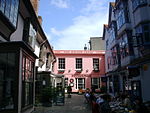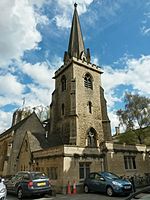Oxford Town Hall
Buildings by Henry HareCity and town halls in OxfordshireGovernment buildings completed in 1897Grade II* listed buildings in OxfordJacobethan architecture ... and 2 more
Local government in OxfordUse British English from April 2022

Oxford Town Hall is a public building on the street called St Aldate's in central Oxford, England. It is both the seat of Oxford City Council and a venue for public meetings, entertainment and other events. It also includes the Museum of Oxford. Although Oxford is a city with its own charter, the building is referred to as the "Town Hall". It is Oxford's third seat of government to have stood on the same site. The present building, completed in 1897, is Grade II* listed.
Excerpt from the Wikipedia article Oxford Town Hall (License: CC BY-SA 3.0, Authors, Images).Oxford Town Hall
St Aldate's, Oxford City Centre
Geographical coordinates (GPS) Address External links Nearby Places Show on map
Geographical coordinates (GPS)
| Latitude | Longitude |
|---|---|
| N 51.751666666667 ° | E -1.2572222222222 ° |
Address
Oxford Town Hall
St Aldate's
OX1 1BX Oxford, City Centre
England, United Kingdom
Open on Google Maps










